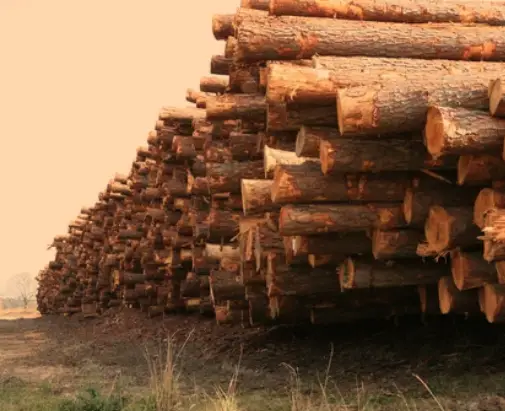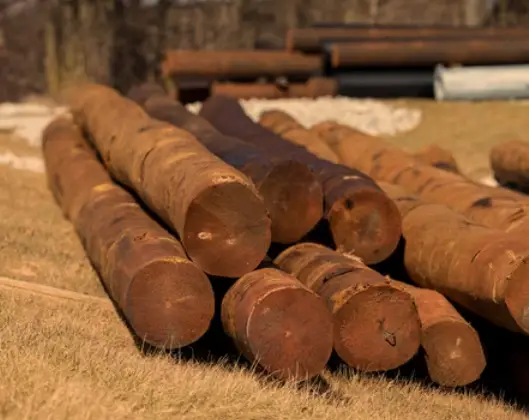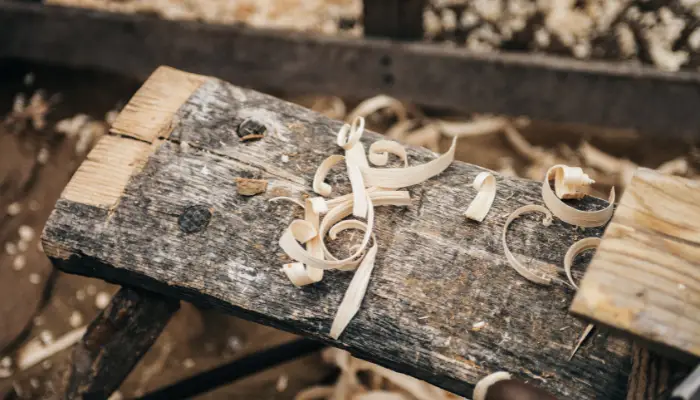Is Creosote-Treated Wood Dangerous? A Comprehensive Analysis
Creosote-treated wood has been used for many years as a way to protect wood from rot and decay.
It is commonly used in outdoor settings such as in railroad ties, utility poles, and fencing.
However, there has been some concern about the potential dangers of using creosote-treated wood, particularly in buildings occupied by humans.
According to the U.S. Agency for Toxic Substances & Disease Registry (ATSDR), creosote-treated wood can pose several health risks to humans.
These risks include respiratory illnesses, skin damage, and eye damage. In addition, the chemicals in creosote can enter the air and can also build up in plants and animals, which can also pose a risk to humans who consume these organisms.
While creosote-treated wood is effective in protecting wood from pests and decay, it is important to consider the potential risks associated with its use.
Homeowners should take precautions when handling creosote-treated wood, such as wearing gloves and a mask, and should avoid using it in areas where it may come into contact with humans or animals.
What is Creosote?

Creosote is a dark brown or black, oily liquid that has a strong, smoky odor. It is a byproduct of burning wood, coal, or other organic materials. Creosote is commonly found in the chimney of a wood-burning fireplace or stove and can also be used as a wood preservative.
When wood is burned, the smoke that rises up the chimney cools down and condenses on the walls of the chimney. Over time, this buildup of condensed smoke forms a sticky, tar-like substance called creosote. Creosote can be dangerous because it is highly flammable and can cause chimney fires if it is not removed regularly.
Creosote can also be dangerous if it is used as a wood preservative. According to the US Environmental Protection Agency (EPA), creosote has been used as a wood preservative since the mid-1800s. However, it poses cancer and non-cancer health risks of concern to workers in wood treatment facilities. The health risks include respiratory illnesses, skin damage, and eye damage.
It is important to note that creosote-treated wood is not recommended for use in buildings occupied by humans due to the potential health risks. The U.S. Agency for Toxic Substances & Disease Registry (ATSDR) lists several potential dangers of using creosote-treated wood, including respiratory illnesses, skin damage, and eye damage.
In summary, creosote is a byproduct of burning wood that can be dangerous if it is not removed regularly from chimneys or if it is used as a wood preservative. It is important to take precautions to prevent the buildup of creosote in chimneys and to avoid using creosote-treated wood in buildings occupied by humans.
Potential Health Risks of Creosote-Treated Wood

Creosote-treated wood is commonly used in outdoor settings such as in decks, fences, and playground equipment. However, it poses certain health risks that people should be aware of.
According to the US Environmental Protection Agency (EPA), creosote is a known carcinogen and can cause cancer in workers who are exposed to it in wood treatment facilities. Additionally, inhalation of creosote fumes can cause respiratory problems, including irritation of the nose, throat, and lungs. Workers who handle creosote-treated wood after application may also experience skin irritation.
While the EPA did not find health risks of concern for the general public, it is still important to take precautions when working with or around creosote-treated wood. This includes wearing protective clothing and gloves, washing skin thoroughly with soap and water after contact, and avoiding inhaling sawdust or fumes.
It is also important to note that creosote-treated wood should not be burned in fireplaces or stoves, as this can release harmful chemicals into the air. Instead, it should be disposed of properly according to local regulations.
Overall, while creosote-treated wood is a durable and long-lasting material, it is important to be aware of the potential health risks associated with its use and take appropriate precautions to minimize exposure.
Environmental Impact of Creosote-Treated Wood
Creosote is a wood preservative pesticide that is commonly used in outdoor settings such as in railroad ties and utility poles. It protects wood against termites, fungi, mites, and other pests that can degrade or threaten the integrity of wood products [1]. However, the use of creosote-treated wood has been linked to several environmental concerns.
One of the main environmental concerns associated with creosote-treated wood is the leaching of toxic chemicals into the surrounding soil and water. The chemicals in creosote can contaminate groundwater and soil, leading to potential health hazards for humans and wildlife. According to the U.S. Agency for Toxic Substances & Disease Registry (ATSDR), exposure to creosote can cause respiratory illnesses, skin damage, eye damage, and other health risks [3].
Another environmental concern associated with creosote-treated wood is the impact on air quality. When creosote-treated wood is burned, it releases harmful chemicals into the air, including polycyclic aromatic hydrocarbons (PAHs) and volatile organic compounds (VOCs). These chemicals can contribute to air pollution and have been linked to respiratory problems and other health issues [2].
Furthermore, the disposal of creosote-treated wood can also have negative environmental impacts. When creosote-treated wood is disposed of in landfills, the chemicals in the wood can leach into the surrounding soil and water. This can lead to contamination of groundwater and soil, which can have long-term environmental effects.
Overall, the use of creosote-treated wood can have significant environmental impacts. While it is an effective wood preservative, the potential risks associated with its use should be carefully considered. Alternative wood preservatives and treatment methods may be available that are less harmful to the environment and human health.
[1] US EPA. Creosote. Retrieved from https://www.epa.gov/ingredients-used-pesticide-products/creosote
[2] Family Handyman. What Is Creosote and Why Is It Dangerous? Retrieved from https://www.familyhandyman.com/article/what-is-creosote/
[3] ATSDR. Creosote Health Effects. Retrieved from https://www.atsdr.cdc.gov/sites/KerrMcGee/docs/Creosote%20Health%20Effects%20(Tronox).pdf
Safe Handling and Disposal of Creosote-Treated Wood

Creosote-treated wood is commonly used for outdoor structures like fences, decks, and retaining walls. However, it is important to handle and dispose of this type of wood properly to avoid potential health and environmental risks.
When handling creosote-treated wood, it is recommended to wear gloves and protective clothing to prevent skin contact. Avoid inhaling sawdust from treated wood by wearing a mask or working in a well-ventilated area. If power-sawing or machining, wear goggles to protect your eyes from flying particles.
To dispose of creosote-treated wood, do not burn it in open fires or in stoves, fireplaces, or residential boilers because toxic chemicals may be released into the air. Instead, dispose of treated wood by ordinary trash collection or burial. Do not use treated wood for cutting boards or countertops, or where the preservative may become a component of food or animal feed.
It is important to note that creosote-treated wood should not be used where it may come into direct or indirect contact with drinking water or with soil that may be used to grow food crops. The U.S. Environmental Protection Agency (EPA) has classified creosote as a “probable human carcinogen,” meaning it may increase the risk of cancer with long-term exposure. Workers in wood treatment facilities are at higher risk of exposure to creosote and should take additional precautions to protect themselves.
In summary, safe handling and disposal of creosote-treated wood is important to avoid potential health and environmental risks. By following proper precautions and disposal methods, individuals can help protect themselves and their communities.
Alternatives to Creosote-Treated Wood
Creosote-treated wood is a commonly used wood preservative, but it is also known to be dangerous to human health and the environment. Fortunately, there are several alternatives to creosote-treated wood that are safer and more environmentally friendly.
Wood Treated with Other Preservatives Approved by EPA
The Environmental Protection Agency (EPA) has approved several wood preservatives that are safer than creosote. These include copper-based preservatives, which are effective against decay and insects, and borate-based preservatives, which are effective against decay and termites. These preservatives are available in various forms, including pressure-treated lumber, which is widely used in construction.
Wood-Alternative and Composite Materials
Wood-alternative and composite materials, such as steel, fiberglass-reinforced concrete, and laminated wood, are also effective alternatives to creosote-treated wood. These materials are durable, long-lasting, and require little maintenance. They are also resistant to decay, insects, and fire.
Species of Wood that are Resistant to Pests
Some species of wood are naturally resistant to pests and decay, making them ideal for outdoor use. These include cedar, redwood, and cypress. These woods are also attractive and have a natural beauty that is hard to replicate with other materials.
Disposing of Items Treated with Creosote Safely
If you have items that have been treated with creosote, such as old railroad ties or telephone poles, it is important to dispose of them safely. Creosote is a toxic substance that can leach into the soil and groundwater, contaminating the environment. The best way to dispose of creosote-treated items is to contact your local waste management facility for guidance. They will be able to advise you on the proper disposal methods and regulations in your area.
Regulations and Guidelines on Creosote Use
Creosote is a wood preservative that has been used for many years to protect wood from rot, insects, and decay. However, creosote-treated wood can be dangerous if not used and disposed of properly. Therefore, there are regulations and guidelines in place to ensure the safe use and disposal of creosote.
In the United States, the Environmental Protection Agency (EPA) regulates the use of creosote under the Federal Insecticide, Fungicide, and Rodenticide Act (FIFRA). Creosote is considered a restricted-use pesticide, and it can only be applied by certified pesticide applicators. The EPA also requires warning labels on products containing creosote to inform users of the potential health hazards.
The Resource Conservation and Recovery Act (RCRA) is another federal law that regulates the disposal of hazardous waste, including creosote-treated wood. RCRA requires that creosote-treated wood be disposed of in a permitted hazardous waste landfill or incinerator. Burning creosote-treated wood in a residential setting is prohibited because it can release toxic chemicals into the air.
In Great Britain, the use of creosote-treated wood is also regulated. The Wood Protection Association (WPA) has guidelines for the use and disposal of creosote-treated wood. The WPA recommends that creosote-treated wood only be used in certain applications, such as railway sleepers and utility poles. When creosote-treated wood reaches the end of its service life, it must be disposed of in accordance with hazardous waste regulations.
Overall, it is important to follow the regulations and guidelines on creosote use to ensure the safety of people and the environment. The improper use and disposal of creosote-treated wood can have serious consequences, including health hazards and environmental contamination.
Conclusion
In conclusion, creosote-treated wood poses several potential dangers to human health and the environment. Exposure to creosote can cause respiratory illnesses, skin damage, eye damage, and other health issues. The chemicals in creosote can also enter the air and build up in plants and animals, which can have negative effects on the environment.
It is important to take precautions when working with or around creosote-treated wood. This includes wearing protective gear such as gloves, goggles, and masks, as well as avoiding direct contact with the wood. It is also important to properly dispose of any creosote-treated wood and to avoid burning it in fireplaces or stoves.
Overall, while creosote-treated wood can be useful in certain applications, it is important to be aware of the potential risks and to take steps to minimize exposure and protect oneself and the environment.
Frequently Asked Questions
What are the potential health risks associated with creosote-treated wood?
Creosote-treated wood can pose significant health risks, including skin damage such as rashes, blistering, and peeling. Exposure to creosote fumes can also cause eye damage, including increased sensitivity to light. Additionally, both the International Agency for Research on Cancer and the U.S. Environmental Protection Agency have determined that creosote exposure can potentially cause cancer in humans.
Has the use of creosote in wood treatment been banned in some countries?
Yes, the use of creosote in wood treatment has been banned in some countries due to its potential health risks. In the United States, the use of creosote-treated wood is regulated by the Environmental Protection Agency (EPA) and is only allowed for certain industrial applications.
Can breathing in creosote fumes be harmful?
Yes, breathing in creosote fumes can be harmful. Creosote fumes can cause respiratory issues and can potentially cause cancer in humans.
What are some alternative treatments for wood that don’t involve creosote?
There are several alternative treatments for wood that don’t involve creosote, such as copper-based treatments, borate-based treatments, and acetylation. These treatments are generally considered safer for human health and the environment.
Is it safe to use creosote-treated wood for indoor projects?
It is generally not recommended to use creosote-treated wood for indoor projects due to the potential health risks associated with creosote exposure. If you must use creosote-treated wood indoors, it is important to take precautions such as wearing protective gear and ensuring proper ventilation.
How long does it take for creosote to dissipate from treated wood?
Creosote can take several years to dissipate from treated wood, depending on factors such as temperature, humidity, and exposure to sunlight. It is important to handle creosote-treated wood with caution and to avoid prolonged exposure to creosote fumes.








